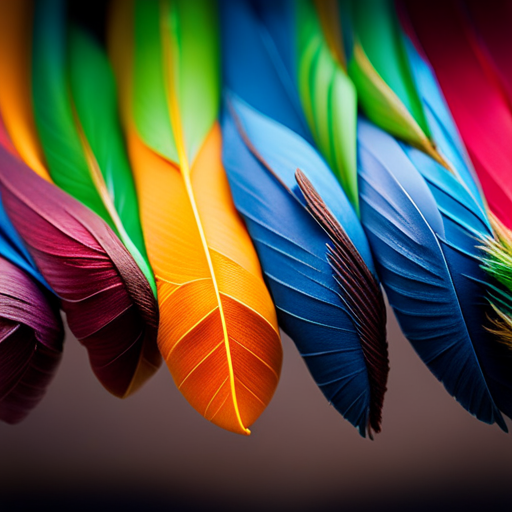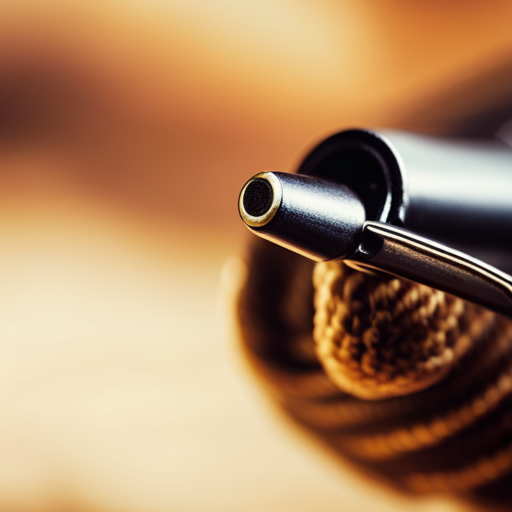In the world of fly tying, the choice of feathers plays a pivotal role in creating successful and visually appealing flies. These diverse feathers offer a myriad of colors, textures, and unique characteristics, making them essential tools for fly tyers.
Consider, for example, the vibrant and iridescent plumage of the peacock, or the soft and supple nature of the marabou feather. These feathers have specific qualities that make them popular choices among fly tyers.
Peacock feathers, with their striking colors and natural shine, are often used to create flashy and attractive patterns. The long and flowing fibers of these feathers provide movement and lifelike action in the water, making them excellent for imitating insects or baitfish.
On the other hand, marabou feathers, known for their softness and fluffiness, are commonly used to create flies with a more realistic and lifelike appearance. The wispy nature of marabou feathers gives flies a subtle and enticing movement in the water, making them irresistible to fish.
In addition to peacock and marabou feathers, there are numerous other types of feathers that fly tyers use for various purposes. These include feathers from ducks, geese, roosters, and many other birds. Each type of feather has its own unique characteristics and can be used to achieve different effects in fly tying.
Overall, the world of fly tying feathers is a rich tapestry of colors, textures, and creative possibilities. Whether you’re looking to create a flashy attractor pattern or a realistic imitation, the right choice of feathers can make all the difference in the success of your flies.
Types of Fly Tying Feathers
When it comes to fly tying, the types of feathers used vary widely, with each type offering unique characteristics and benefits for creating effective and visually appealing flies. Feather sizes and textures play a crucial role in determining the appearance and behavior of the fly in water.
Larger feathers are often used for streamers and saltwater flies, providing buoyancy and movement, while smaller feathers are preferred for dry flies and nymphs, offering delicate and realistic imitations. Additionally, the texture of the feathers affects how they interact with water, influencing the fly’s presentation and effectiveness in attracting fish.
Feather sourcing is a critical consideration for fly tiers, with many seeking sustainable options to minimize environmental impact. Ethical sourcing practices ensure the responsible harvesting of feathers, supporting conservation efforts and protecting bird populations. Sustainability in feather sourcing extends to the use of alternative materials and synthetic substitutes, offering environmentally friendly options for fly tying without compromising on quality.
Transitioning into the subsequent section about ‘color variations in feathers’, it is important to note that the diverse range of natural feather colors adds another dimension to fly tying, allowing anglers to closely match the hatch and entice selective fish.
Color Variations in Feathers
Exploring the diverse color variations in feathers enhances the aesthetic and functional aspects of fly tying, offering anglers the opportunity to closely mimic natural prey and attract discerning fish. When considering feather coloration, natural feathers provide a more authentic appearance, as they possess subtle variations and unique hues that imitate the real insects or baitfish. On the other hand, dyed feathers offer a broader spectrum of colors, allowing anglers to experiment with vibrant and unconventional shades to create eye-catching patterns. The choice between natural and dyed feathers depends on the specific fishing conditions and the angler’s preference for realism or creativity.
Feather patterning also plays a crucial role in fly tying. Mottled feathers, with their irregular and speckled appearance, can add depth and dimension to fly patterns, closely resembling the natural mottling found on insects. In contrast, solid-colored feathers provide a more uniform and consistent look, which can be advantageous when imitating certain prey species or creating attractor patterns that stand out in the water. The selection of mottled or solid feathers can evoke feelings of nostalgia for traditional fly patterns or excitement for innovative and unconventional designs.
Unique Characteristics of Feathers
Feathers exhibit unique characteristics that contribute to the versatility and effectiveness of fly tying patterns. Understanding feather anatomy is crucial for fly tyers to select the right feathers for specific patterns.
Each part of a feather serves a purpose in fly tying. The barbules, hook, and barbs are essential components that determine how a feather can be used in creating different types of patterns. For instance, feathers with softer barbs are ideal for creating delicate patterns such as dry flies, while feathers with stiffer barbs are more suitable for creating patterns like streamers or nymphs.
Feather selection is also influenced by the shape and size of the feather. The shape of the feather determines its application, with rounded feathers being suitable for wings, while elongated feathers are often used for tails and legs. Additionally, the size of the feather impacts the overall size and silhouette of the fly pattern.
Feather Preparation and Handling
The proper preparation and handling of feathers are essential steps in the fly tying process, ensuring that their unique characteristics are preserved and utilized effectively to create high-quality fly patterns. To evoke emotion in the audience, consider the following key points:
-
Respect the Natural Integrity: Feather preparation techniques should prioritize maintaining the natural integrity of the feathers. This involves careful washing and drying to remove any dirt, oils, or debris without damaging the delicate barbules.
-
Gentle Storage Methods: Proper storage methods are crucial to preserve the pristine condition of feathers. Utilize breathable containers or bags to prevent moisture buildup, which can lead to mold and decay. Additionally, storing feathers away from direct sunlight and extreme temperatures helps maintain their color and structural integrity.
-
Appreciation for Feather Diversity: Each feather is unique, and handling them with care and appreciation honors their diversity. Understanding the different characteristics of feathers and how they can be utilized in fly tying enhances the creativity and artistry of the process.
Creative Applications in Fly Tying
Utilizing the diverse characteristics of feathers, creative applications in fly tying showcase the artistry and innovation inherent in crafting unique and effective fly patterns. Feather selection is a critical aspect of this creativity, as different feathers offer distinct colors, textures, and shapes that can be combined to produce visually striking and functional flies. Artistic expression is at the heart of this process, with fly tyers drawing inspiration from nature and their own imagination to create patterns that not only imitate natural prey but also possess an aesthetic appeal.
The historical significance and cultural influence of creative fly tying are profound. Throughout history, fly tying has been intertwined with various cultural traditions, from indigenous fishing practices to the aristocratic pursuits of European nobility. Different cultures have developed their own unique styles of fly patterns, often reflecting the local flora and fauna.
Today, this diversity continues to enrich the art of fly tying, as contemporary tyers draw from this rich tapestry of traditions to create innovative and culturally resonant patterns. In this way, creative applications in fly tying not only serve practical purposes but also contribute to the preservation and celebration of diverse cultural and historical influences.
Frequently Asked Questions
Can I Use Feathers From My Backyard Chickens for Fly Tying?
Yes, feathers from backyard chickens can be used for fly tying. However, it’s important to ensure that feather sourcing is done ethically and legally, considering conservation and the potential impact on exotic bird populations.
Are There Any Ethical Considerations to Keep in Mind When Using Feathers for Fly Tying?
When using feathers for fly tying, it’s crucial to consider ethical implications and sustainable sourcing. Respecting the origin of feathers, such as avoiding protected species, ensures responsible angling practices and conservation of natural resources.
Can Feathers From Exotic Birds Be Legally Obtained for Fly Tying?
Legal sourcing of feathers from exotic birds for fly tying is subject to specific regulations. Conservation efforts and ethical sourcing are crucial in obtaining these feathers. Compliance with international and local laws is essential for responsible acquisition.
How Can I Store My Feathers to Keep Them in the Best Condition for Fly Tying?
To store feathers for fly tying and preserve their quality, ensure they are clean and dry before placing them in a cool, dark, and dry environment. Whether sourced from backyard chickens or ethically acquired, proper storage is crucial.
Are There Any Special Techniques for Dyeing Feathers for Fly Tying?
Feather preparation and dyeing techniques are crucial for fly tying. To ensure sourcing legal feathers and support conservation efforts, it’s essential to use ethical practices. Proper dyeing methods can enhance the diversity of feathers for fly tying.
Conclusion
In conclusion, the exploration of the diversity of fly tying feathers reveals the wide variety of types, colors, and unique characteristics available for creative applications in fly tying. Understanding the preparation and handling of feathers is essential for achieving the desired results.
As the saying goes, ‘feathers of a feather flock together,’ and it is important to select the right feathers for the intended fly pattern. The diversity of feathers offers endless possibilities for fly tying enthusiasts.




